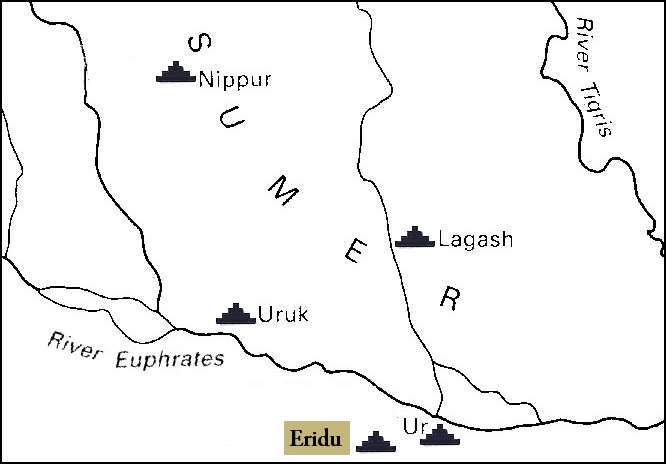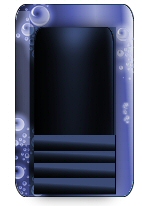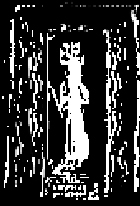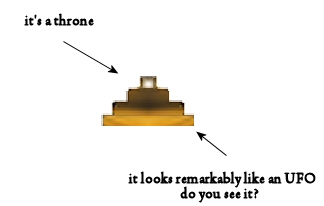THE STAR*GATES
by E. Vegh © 2006
The Sumerian Thread: As Above,
So Below
Table of Contents
Self-education is, I firmly believe,
the only kind of education there is.
- Isaac Asimov, Scientist, Author
"Deep Space"
Some consider the phrase, "As above,
so below," to have magical implications. But what if the meaning was, originally,
something quite different? What if knowledge of the ancient past has been
so entrenched in long forgotten meanings and half-hidden symbols, that
we've inadvertently misconstrued the interpretation of those symbols? Let's
consider one such symbol: the hourglass shape.

It is the visual embodiment of "As
above, so below." Scientifically, only physics effect its application and
change its meaning. It will be a major theme of this book and for good
cause: it's found throughout ancient history, particularly in religious
artforms and almost always in connection with the gods. However, to do
the subject justice, we need to start at the beginning.
THE BEGINNING.....sorta
Once upon a time in the land of ancient
Sumer [1], in
what is now modern day Iraq, there was a city called "Eridu." It was the
first known civilization (to date). It sprung up from seemingly nowhere,
having been previously and intermittently inhabited by wandering nomads
and hunter-gatherers.

Map of Sumer
It was presided over by the Anunnaki
"god," Enki. He was not only its ruler, he was also its designer and founder.
His throne and abode, called the "E.ABZU" or "E.ENGURRA", was the first
ziggurat ever built (to our knowledge) and had several unique features,
frequently overlooked by readers of the ancient sumerian texts. For example,
it was made of silver "bricks," covered in gold, produced roaring sounds,
and its walls could talk and offer advice. And, if that weren't
enough, it could also float on the water and hover in the air! Observe
the following quotes from "Enki and the World Order":
An artfully made bright
crenellation rising out from the abzu was erected for lord Nudimmud. Enki,
the lord who determines the fates, built up his temple entirely from silver
and lapis lazuli. Its silver and lapis lazuli were the shining daylight.
[...]
Your door is a lion who {seizes a
man} [...]
Its brickwork makes utterances and
gives advice. [...]
He built the temple from precious
metal, decorated it with lapis lazuli, and covered it abundantly with gold.
[...]
As it has been built, as it has been
built; as Enki has raised Eridug up, it is an artfully built mountain which
floats on the water. [4]
Samuel Noah Kramer, an assyriologist
who was the first to translate many of the sumerian texts, said in his
book "Enki Builds the E-Engurra":
The lord of the abyss, the
king Enki, Enki the Lord who decrees the fates, Built his house of silver
and lapis lazuli; Its silver and lapis lazuli, like sparkling light, The
father fashioned fittingly in the abyss.
[...]
Then Enki raises the city of Eridu
from the abyss and makes it float over the water like a lofty mountain.

Enki's Ziggurat
This would all seem harmless enough,
were Enki's story a fairy tale about a fictious place. But in fact, it
was quite real. Eridu was a real city in ancient Sumer, and Enki's E.ABZU
was a real .....building (that apparently defied the laws of gravity in
4000 BC!). Obviously, a "building" made of silver and covered with
gold, would sink immediately (if not sooner) and therefore, could not float
on the water or above it, for that matter. Alas, this amazing feat of architectural
(or mechanical) engineering has vanished, being either a victim of the
mesopotamian flood, the vengeance of God, thievery, the spoils of war,
or has long since launched itself into space (why not? It could do everything
else!)!
Equally unusual was Enki's boat,
which apparently needed no oars: "The ship departs of its own accord, with
tow rope held (?) by itself" [2]
and it gurgles as it moves down the river. Yes, this Enki sure is an interesting
character, isn't he? And we're just getting started!
By far the most mysterious of Enki's
properties was the "ABZU" (also called "Apsu"). The ABZU was underneath
the E.ABZU when it was on dry land, that is, it was a subterranean chamber
under the spot where Enki parked his ziggurat in Eridu, a basement of sorts.
Enki and the other "gods," frequently met there to discuss important matters.
Oddly enough, it's also referred to as an underground chamber of "sweet"
or "fresh" water, a water vessel for temple rituals, the abyss, the bottomless
pit, the deep, and in the Enuma Elish, Abzu was a god from which the gods
and sons of god, emerged. All these concepts don't appear to have much
in common on first glance, but they actually apply to different aspects
of the ABZU, which is why it has been so terribly misunderstood as an ancient
symbol.

The ABZU
|

The ABZU with water flowing around the door frame, steps going up,
and the figure of Enki inside, from an ancient sumerian cylinder seal.
|
Note and remember for future reference,
that Samuel Noah Kramer had already translated the word Abzu to be Abyss,
meaning that the Abzu and the Abyss were one in the same. In fact, it is
my contention that the word "Abzu" was the etymological origin of the word
"Abyss." Thusly, Enki's E.ABZU, his E-ENGURRA, his ziggurat, rose up out
of the Abzu, already completed, and floated above the water. Mainstream
assyriologists assume the Abzu was in fact a reference to underground rivers
of fresh water. However, were this the case, it couldn't very well be the
ocean. Assuming the Abyss or the Abzu are references to the ocean is, therefore,
in direct contradiction with the ancient sumerian texts. The fresh water
and salty water are not interchangeable.
Keep in mind, that the ancient past
has been foraged from for millenia, to uphold various religious or non-religious
positions, which by necessity, requires some descriptions be virtually
ignored, while favoring others. But let's see what happens when all the
descriptions are applied and the symbols are re-interpreted as an integrated
whole. To achieve this with the ABZU references, we also need to incorporate
related, associated symbols. One such association is the dragon or "Tiamat."
Tiamat also had the distinction of
several different descriptions that seem totally unrelated. In the ancient
texts it was referred to as a dragon, a monster, the salt water ocean or
sea, the water of chaos, a goddess of birth, a constellation, and the gods
and sons of god, also emerged from it. [3]
Some pick only the dragon definition to elaborate on, while others choose
the water of chaos, the ocean salt water, or the birth goddess. And still
others, assume Tiamat and Abzu are one in the same. And, they are all correct!
Each of those definitions do indeed fit Tiamat, although it isn't the "Abzu"
(or vice-a-versa), specifically, it does merge with the Abzu and
even says as much in the ancient texts. Allow me to explain:
You see, the ABZU was an entrance
to another place or many other places. It was a subterranean gate, apparently
filled with swirling water, like a whirlpool. In the following excerpts,
notice the gate is a conduit betwen the earth and heaven. Some believe
that it simply meant the top of the Ziggurat was heaven and the bottom
of the Ziggurat was the earth, but that doesn't fit with the rest of the
information, especially the references to the gate connecting the "holy
shrine" in the depths of the "sea" (a misunderstanding of "ABZU", which
was also known as the "abyss") and the Field Constellation:
Your great house is founded
in the Abzu, the great mooring-post of heaven and earth. [...]
The lord established a shrine,
a holy shrine, whose interior is elaborately constructed. He established
a shrine in the sea, a holy shrine, whose interior is elaborately constructed.
The shrine, whose interior is a tangled thread, is beyond understanding.
The shrine's emplacement is situated by the constellation the Field, the
holy upper shrine's emplacement faces towards the Chariot constellation.
(emphasis, mine)
[4]
It was a doorway of sorts, a gate to
the "netherworld" which was in reality, a gate to outerspace, and it had
at least one exit somewhere by the constellation "The Field" (possibly
a reference to the Great Square of Pegasus, more on that later). It was
the access point to Enki's meeting chamber and at least one of his very
special throne rooms.
However, every entrance or exit,
needs a hallway in order to get from point A to point B, and that's where
Tiamat comes in. Tiamat is the pathway through the hourglass. It embodies
the application of "As above, so below," the figure eight ouroboros and
the infinity loop. In short, Tiamat was a wormhole connected to the ABZU,
which was the gate of the wormhole. The two "waters", salt and sweet, merged
at the gate, creating a swirling vortex, the watery chaos of Tiamat.
And I quote:
Your door is a lion who
{seizes a man} [...]
With such a connection to the Earth,
the gods and sons of god, could literally emerge from the ABZU, be "born"
from it. It would appear as if the ABZU were giving birth from the birth
canal of Tiamat's swirling waters. These are the "primeval" waters from
which the prototype, primeval mound (Enki's E.ABZU), arose. This is also
the origin of the belief that an interdimensional gate is opened via sex
magic: The ziggurat or pyramid (and later, the obelisk and benben)
representing a phallic symbol and the Gate and Tiamat, representing the
vaginal opening and birth canal.
So, let's review what we know about
Tiamat, so far:
1. Tiamat as a dragon, referencing
that it's a wormhole, an ouroboros pathway.
2. Tiamat as "salt water ocean"
merging with the freshwater ABZU, the two waters combining in a swirling
whirlpool at the ABZU gate entrance.
3. Tiamat as the water of chaos,
referencing the whirlpool formed at the ABZU gate connection to the wormhole.
4. Tiamat as a goddess of birth,
referencing the emerging of the "gods" from the wormhole through the ABZU
gate.
5. Tiamat as a constellation,
referencing the wormhole connection to a place near the "Field Constellation."

Tiamat?
Before you toss out the idea as ludicrous,
consider that Enki's E.ABZU "ziggurat" (if you can really call it that),
was entirely made of metals, talked, floated, hovered, made "roaring" sounds,
glowed so brightly it lit up the area, had an interior that was "a tangled
thread beyond understanding," had a door that "seizes a man", was connected
to the Field Constellation, and gave advice! This was not an ordinary ziggurat,
in fact, it was one of the first prototypes for all subsequent ziggurats,
after the flood. However, the subsequent buildings did not have interiors
that were "tangled threads beyond understanding!" Let's look at the picture
again:

Enki's Ziggurat
Do you notice anything unusual about
the shape of the ziggurat? If not, allow me to point out a few things:

It was the prototype for not only
later ziggurats, it was also the prototype for earthly "thrones" of glory,
such as the throne of the Emperor of China:

The Golden Dragon Throne
This leads us to the next question:
so why and how would the god Enki build a space craft in ancient Eridu?
From the textual evidence, it doesn't appear as if it was built in Eridu,
but rather it came out from somewhere in the ABZU. It was already "built"
when it rose out of the ABZU, and I quote: "An artfully made bright crenellation
rising out from the abzu was erected for lord Nudimmud."[2]
It simply rose up from the ABZU and planted itself on the spot. It "landed."
Samuel Noah Kramer also describes this event, saying, "Then Enki raises
the city of Eridu from the abyss and makes it float over the water like
a lofty mountain."
It could be argued that the story
is really just referring to the construction of the building, "rising"
up as it was being built. If such is the case, he apparently built it from
a model of something else he was intimately familar with and endowed it
with some technically advanced features, considering the time frame! Afterall,
how many of the post-flood ziggurats were composed "entirely of silver"
(those bricks weren't just glazed with silver, they were "entirely" silver,
covered with gold) and could "float?" Answer: none, as the post-flood ziggurats
were simple mud brick constructions, crude copies of the original, which
appears to have been a spacecraft and watergoing vessel of glowing metals!
And, this is just the beginning!
Now, let's look at the technological aspects of the ABZU's counterpart,
the dragon or Tiamat, on the next page.
Footnotes
1 Ancient Sumer was
the first civilization on the planet (to date). It was ushered in by the
Anunnaki, who taught the people music, the sciences, astronomy, languages
(both spoken and written), mathematics, herbology, manipulation of the
environment, hybridization of crops, genetic manipulation of livestock,
religion, sexual promiscuity, war, mining for resources, jewelry-making,
tailoring, blacksmithing, architecture, art, poetry, human sacrifice, and
the whole gamut of "civilized behaviors."
2Enki's
journey to Nibru: translation, The Electronic Text Corpus of Sumerian
Literature. Black, J.A., Cunningham, G., Ebeling, J., Flückiger-Hawker,
E., Robson, E., Taylor, J., and Zólyomi, G., The Electronic Text
Corpus of Sumerian Literature (http://etcsl.orinst.ox.ac.uk/), Oxford 1998-
.
3
"Tiamat." Encyclopedia Mythica from Encyclopedia Mythica Online. [Accessed
February 24, 2006].
4Enki
and the world order, Black, J.A., Cunningham, G., Ebeling, J., Flückiger-Hawker,
E., Robson, E., Taylor, J., and Zólyomi, G., The Electronic Text
Corpus of Sumerian Literature (http://etcsl.orinst.ox.ac.uk/), Oxford 1998-
. The Electronic Text Corpus of Sumerian Literature
<-Back -1- Next->
|

